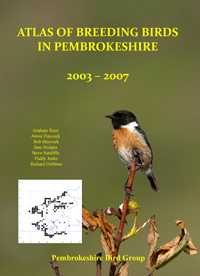Phalaropus fulicarius
Most Grey Phalaropes have been seen on or over the sea but they have been found occasionally on estuarine waters, coastal pools and floodwater, at the Gann, Bosherston, Newgale, Carew Mill Pond and Orielton, with inland occurrences at Letterston, Loveston, Narberth, Haverfordwest and Pembroke.
Cumulative total birds by month,1904 – 2006.

Mostly single birds were seen but occasionally up to 10 in a day, however, there have been large scale incursions, or “wrecks”, into the South West Approaches which reached Pembrokeshire. During a “wreck” in 1891 Mathew noted they were “numerous”, particularly around Caldey. During a similar but better documented event in 1960, there were up to 35 at Skokholm during the 18th to 27th September and 227 around The Smalls on the 29th September. An incursion in 2001 resulted in a total of 39 being recorded around the Pembrokeshire coast between the 6th and 9th October.
August records fell between the 12th and 31st, apart from three sightings on the 2nd, at Little Haven in 1985 and at Strumble Head in 1986 and 2000. August birds exhibited varying traces of summer plumage, so were adults and probably females, as they take no part in incubation or rearing young and depart the breeding grounds much earlier than the males which are then still involved in the breeding process.
The early year records suggest that a few spend the winter at the same latitude as Pembrokeshire. These were: singles at The Smalls on the 2nd January 1985, Dale and Freshwater West on the 13th February 1971 and Pembroke on the 17th March 1928.
Although there are no ring recoveries to prove it, those occurring in British and Irish waters probably come from Iceland, Bear Island and Svalbard, possibly also from east Greenland and Noveya Zemla. However the number involved in years when “wrecks” occurred may mean that birds from Canada and west Greenland were involved.
Graham Rees
(Covers records up to and including 2006)
 Tuesday, December 28, 2010 at 6:07PM
Tuesday, December 28, 2010 at 6:07PM  GHR,
GHR,  Wader,
Wader,  migration,
migration,  spring in
spring in  Spotted Redshank
Spotted Redshank 




